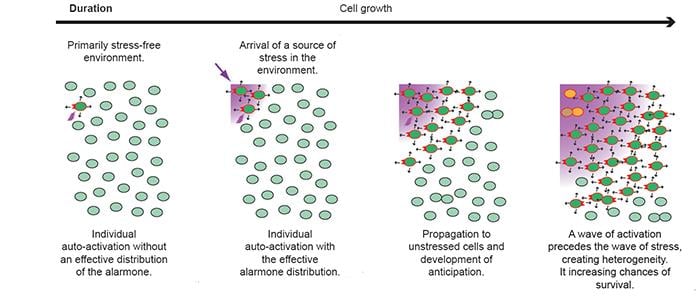Scientists have discovered a previously unknown defense mechanism in bacteria that allows them to warn their neighbors about incoming threats. This finding could revolutionize our approach to developing new antibiotics and combating antibiotic resistance.
A Bacterial Early Warning Network
When bacteria encounter antibiotics or other stressors, they don’t just defend themselves – they spread the word. Researchers from CNRS and Université de Toulouse III – Paul Sabatier have identified a sophisticated communication system that bacteria use to alert and protect their communities.
The mechanism, dubbed Self Induction and Propagation (SI&P), works like this: Stressed bacteria produce small proteins called “alarmones” on their surface. These alarmones can activate nearby bacteria through direct contact. However, this activation only occurs when enough bacteria are producing alarmones, ensuring a coordinated response to genuine threats.
Implications for Future Antibiotic Development
This discovery, published in Nature Communications, opens up new possibilities for tackling antibiotic-resistant bacteria. By targeting this communication system, future treatments could potentially disrupt bacterial defenses before they even begin.
The research team focused on Streptococcus pneumoniae, the bacteria responsible for pneumococcal infections. They tested the SI&P mechanism using various antibiotic families, demonstrating its effectiveness across different types of threats.
This bacterial warning system offers several advantages for survival:
- Energy efficiency: Only activating defenses when necessary conserves resources.
- Rapid, coordinated response: The entire bacterial population can react quickly to threats.
- Increased diversity: Gradual activation creates a varied population, improving overall survival chances.
While this discovery highlights the remarkable adaptability of bacteria, it also provides valuable insights for developing more effective treatments. By understanding how bacteria communicate and coordinate their defenses, scientists may be able to create antibiotics that can outsmart these microbial early warning systems.
As antibiotic resistance continues to pose a global health threat, research like this becomes increasingly crucial. The bacterial alarm system may have been uncovered, but the race to stay ahead in the battle against harmful microbes is far from over.


